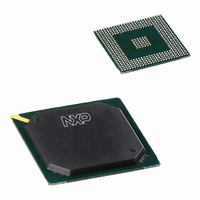PNX1502E,557 NXP Semiconductors, PNX1502E,557 Datasheet - Page 112

PNX1502E,557
Manufacturer Part Number
PNX1502E,557
Description
IC MEDIA PROC 300MHZ 456-BGA
Manufacturer
NXP Semiconductors
Specifications of PNX1502E,557
Applications
Multimedia
Core Processor
TriMedia
Controller Series
Nexperia
Interface
I²C, 2-Wire Serial
Number Of I /o
61
Voltage - Supply
1.23 V ~ 1.37 V
Operating Temperature
0°C ~ 85°C
Mounting Type
Surface Mount
Package / Case
456-BGA
Lead Free Status / RoHS Status
Lead free / RoHS Compliant
Program Memory Type
-
Ram Size
-
Lead Free Status / Rohs Status
Not Compliant
Other names
935274744557
PNX1502E
PNX1502E
PNX1502E
PNX1502E
Available stocks
Company
Part Number
Manufacturer
Quantity
Price
Company:
Part Number:
PNX1502E,557
Manufacturer:
NXP Semiconductors
Quantity:
10 000
- Current page: 112 of 828
- Download datasheet (8Mb)
Philips Semiconductors
Volume 1 of 1
PNX15XX_SER_3
Product data sheet
2.2 The CPU View
Remark: Partial 32-bit load or stores from a PCI master to an MMIO register is not
supported. Therefore byte of 16-bit half-word accesses are not supported.
The TM3260 CPU supports three different apertures:
Remark: To ensure backward compatibility with future devices, writes to any
undefined or reserved MMIO bit should be ‘0’, and reads should be ignored. This rules
applies to ALL the modules of PNX15xx Series.
TM3260 CPU accesses the three apertures using regular load/store operations.
Some internal logic in the data cache unit surveys the load/store addresses and
routes the request to the appropriate internal PNX15xx Series registers (this includes
the registers belonging to TM3260) if the address falls into the MMIO aperture. If the
load/store address falls into the DRAM aperture the load/store request is routed to
the data cache and eventually the main memory. Finally if the load/store address falls
into the APERT1 aperture, the request is send to the PCI bus (if it maps to an XIO
device or a PCI internal aperture, see the following
Figure 2
PNX15xx Series system. The apertures can be placed in any order with respect to
each other.
PNX15xx Series allows a host CPU to prevent TM3260 to change its own aperture
registers. This can be obtained by flipping
TM32_CONTROL.TM32_APERT_MODIFIABLE to ‘1’
locations are defined as follows:
Remark: If the value 0x0000,0000 is stored into TM32_DRAM_HI, this value is
understood as 0x1,0000,0000.
•
•
•
•
•
•
the MMIO aperture, used to access all the internal PNX15xx Series registers.
See
the DRAM aperture, used to access the main memory of PNX15xx Series which
contains the instruction and the data for TM3260 and data used by other PCI
masters.
the APERT1 aperture, used by TM3260 to access low speed slave devices like
Flash memories or IDE disk drives that are located in the XIO aperture or any
other PCI slave.
The MMIO aperture is starting at the address contained in the BASE_14 MMIO
register. The register is located and owned by the PCI module. It is equivalent to
the BASE_14 PCI Configuration space register. This is different with respect to
PNX1300 Series or PNX1300 Series where an MMIO_BASE MMIO register was
available.
The DRAM aperture is starting at the address contained in the TM32_DRAM_LO
MMIO register and finishes at TM32_DRAM_HI - 1.
The APERT1 aperture is starting at the address contained in the
TM32_APERT1_LO MMIO register and finishes at TM32_APERT1_HI - 1.
Section 11. on page 3-31
presents the memory map seen by the TM3260 and the remaining of the
Rev. 3 — 17 March 2006
for offset allocation per module.
Chapter 3: System On Chip Resources
Section
© Koninklijke Philips Electronics N.V. 2006. All rights reserved.
(Section
PNX15xx Series
2.3).
2.4.1). The aperture
3-3
Related parts for PNX1502E,557
Image
Part Number
Description
Manufacturer
Datasheet
Request
R
Part Number:
Description:
Digital Signal Processors & Controllers (DSP, DSC) MEDIA PROCESSOR PNX15XX/300MHZ
Manufacturer:
NXP Semiconductors

Part Number:
Description:
IC MEDIA PROC 300MHZ 456-BGA
Manufacturer:
NXP Semiconductors
Datasheet:
Part Number:
Description:
NXP Semiconductors designed the LPC2420/2460 microcontroller around a 16-bit/32-bitARM7TDMI-S CPU core with real-time debug interfaces that include both JTAG andembedded trace
Manufacturer:
NXP Semiconductors
Datasheet:

Part Number:
Description:
NXP Semiconductors designed the LPC2458 microcontroller around a 16-bit/32-bitARM7TDMI-S CPU core with real-time debug interfaces that include both JTAG andembedded trace
Manufacturer:
NXP Semiconductors
Datasheet:
Part Number:
Description:
NXP Semiconductors designed the LPC2468 microcontroller around a 16-bit/32-bitARM7TDMI-S CPU core with real-time debug interfaces that include both JTAG andembedded trace
Manufacturer:
NXP Semiconductors
Datasheet:
Part Number:
Description:
NXP Semiconductors designed the LPC2470 microcontroller, powered by theARM7TDMI-S core, to be a highly integrated microcontroller for a wide range ofapplications that require advanced communications and high quality graphic displays
Manufacturer:
NXP Semiconductors
Datasheet:
Part Number:
Description:
NXP Semiconductors designed the LPC2478 microcontroller, powered by theARM7TDMI-S core, to be a highly integrated microcontroller for a wide range ofapplications that require advanced communications and high quality graphic displays
Manufacturer:
NXP Semiconductors
Datasheet:
Part Number:
Description:
The Philips Semiconductors XA (eXtended Architecture) family of 16-bit single-chip microcontrollers is powerful enough to easily handle the requirements of high performance embedded applications, yet inexpensive enough to compete in the market for hi
Manufacturer:
NXP Semiconductors
Datasheet:

Part Number:
Description:
The Philips Semiconductors XA (eXtended Architecture) family of 16-bit single-chip microcontrollers is powerful enough to easily handle the requirements of high performance embedded applications, yet inexpensive enough to compete in the market for hi
Manufacturer:
NXP Semiconductors
Datasheet:
Part Number:
Description:
The XA-S3 device is a member of Philips Semiconductors? XA(eXtended Architecture) family of high performance 16-bitsingle-chip microcontrollers
Manufacturer:
NXP Semiconductors
Datasheet:

Part Number:
Description:
The NXP BlueStreak LH75401/LH75411 family consists of two low-cost 16/32-bit System-on-Chip (SoC) devices
Manufacturer:
NXP Semiconductors
Datasheet:

Part Number:
Description:
The NXP LPC3130/3131 combine an 180 MHz ARM926EJ-S CPU core, high-speed USB2
Manufacturer:
NXP Semiconductors
Datasheet:

Part Number:
Description:
The NXP LPC3141 combine a 270 MHz ARM926EJ-S CPU core, High-speed USB 2
Manufacturer:
NXP Semiconductors

Part Number:
Description:
The NXP LPC3143 combine a 270 MHz ARM926EJ-S CPU core, High-speed USB 2
Manufacturer:
NXP Semiconductors

Part Number:
Description:
The NXP LPC3152 combines an 180 MHz ARM926EJ-S CPU core, High-speed USB 2
Manufacturer:
NXP Semiconductors











